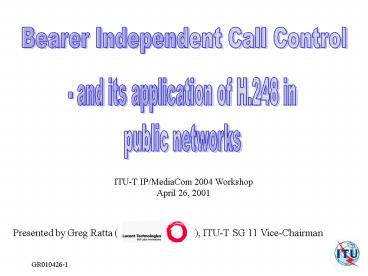Bearer Independent Call Control - PowerPoint PPT Presentation
Title:
Bearer Independent Call Control
Description:
Presented by Greg Ratta ( ), ITU-T SG 11 Vice-Chairman. Bearer ... TSN Transit Serving Node. UNI User Network Interface. VCC Virtual Channel Connection ... – PowerPoint PPT presentation
Number of Views:686
Avg rating:3.0/5.0
Title: Bearer Independent Call Control
1
Bearer Independent Call Control
- and its application of H.248 in public networks
ITU-T IP/MediaCom 2004 WorkshopApril 26, 2001
Presented by Greg Ratta (
), ITU-T SG 11 Vice-Chairman
2
Outline
- Introduction - What is BICC?
- BICC Architecture
- Overview of BICC Capability Set 1
- BICC Capability Set 2 and H.248
- Summary
3
What is BICC?
- BICC provides a means of supporting narrowband
ISDN services across a broadband backbone network
without impacting the interfaces to the existing
N-ISDN network and end-to-end services. - The BICC call control signaling protocol is based
on N-ISUP signaling - The bearer control signaling protocols are based
on different bearer technology control signaling
protocols (e.g., DSS2 for AAL type 1 and AAL
type 2) - The BICC call control signaling protocol should
not be aware of the actual bearer transport being
employed. The binding information is used to
reference the bearer.
4
BICC network architecture
5
BICC Capability Set 1
- Forward and Backward Backbone Network
Establishment - Transport Call Control via MTP SS7 or ATM
- Support of most existing narrow band services.
- New Backbone Network Connection (BNC) with or
without Codec Negotiation - Reuse of Idle Backbone Network Connection (BNC)
- Separate Release of Call and Backbone Network
Connection (BNC) - Bearer Transport Types supported AAL 1 AAL 2
6
Forward bearer set-up and backward bearer set-up
7
Early bearer call SETUP requestto improve
call set-up time
8
Additional confirmation of bearer CONNECT to
prevent speech clipping
9
Structure of the BICC standardization
documentation
10
BICC Capability Set 2 and Beyond
- Extend BICC to the Local Exchanges
- Support IP Bearer, including Tunnelling
- Support of a Call Mediation Node Function
- Support Structured AAL1
- New Identifiers
- Traffic Group
- Global Call Reference
- Extend BICC to Special Resources Nodes (e.g.,
announcement platformsetc) - See list of features attached to this presentation
11
Functional architecture of the decomposed gateway
With BICC CS 1
ISN
12
Functional architecture of the decomposed gateway
With BICC CS 2
RAS
X
Signalling
Termination
High Layer
SCN
H.245
SCN
D
C
X
B1
Z
Resource
Signalling
Signalling
Signalling
Control
Termination
Termination
Transport
Termination
B2
H.225.0
BICC CBC
X
Signalling
H.248
A
Termination
Packet and
Y
Z
Circuit
Decomposed ISN
Media
Termination
13
Network Topologies and Reference Points
14
BICC CS 2 and Beyond
- Q.1902.1, BICC CS2 Functional Description
- Q.1902.2, BICC CS2 General functions of messages
and signals - Q.1902.3, Common Formats and Codes for BICC and
ISUP - Q.1902.4, BICC protocol elements
- Q.1902.5, Exceptions to APM in the context of
BICC - Q.19xx.1, Interworking between BICC and ISUP
- Q.19xx.2, Interworking between ISUP compatible
signalling systems and the BICC protocol - Q.19xx.3, Interworking between the H.225.0
Multimedia Call Control protocol in an H.323
network and the BICC protocol - Q.19xx.4, Interworking DSS 2 to BICC
- Q.19xy, Interaction between the INAP protocol and
the BICC protocol - Q.ibcp, BICC IP Bearer Control Protocol
- Q.cbc, Call and Bearer Control Protocol
- Annex E to Q.1901, Signalling Transport
Convergence for SCTP - Supplements that document the signalling
requirements
15
Summary
- BICC CS 1 Standards were completed in 9 months
- BICC CS 2 uses H.248 in CBC interface
- All new services in ITU-T SG 11 to be specified
for BICC before being added to ISUP or BISUP
16
BICC Acronyms
- AAL ATM Adaptation Layer
- ACF Access Control Function
- ACN Access Concentration Node
- AESA ATM End System Address
- AGI Application Generated Identifier
- ANI Access Network Interface
- APM Application transport Message
- ATM Asynchronous Transfer Mode
- BCF Bearer Control Function
- BF Bearer Function
- BICC Bearer Independent Call Control
- BIWF Bearer Interworking Function
- BNC Backbone Network Connection
- CSF Call Service Function
- CSM Call State Model
- CMN Call Mediation Node
- B-ISUP Broadband ISUP
- DSS2 Digital Signalling System no.2
- GAT Generic Addressing and Transport protocol
- IN Intelligent Networks
- IP Internet Protocol
- ISDN Integrated Services Digital Network
- ISN Interface Serving Node
- ISUP ISDN User Part
- MTP3b Message Transfer Part no.3b
- NNI Network-Network Interface
- POP Point of Presence
- PSTN Public Switched Telephony Network
- SN Serving Node
- SPOI Signalling Point of Interconnection
- SS7 Signalling System no.7
- SSCOP Service-Specific Connection-Oriented
Protocol - STP Signalling Transfer Point
- SWN Switching Node
- TDM Time Division Multiplexing
- TE Terminal Equipment
- TG Trunk Group
- TSN Transit Serving Node

